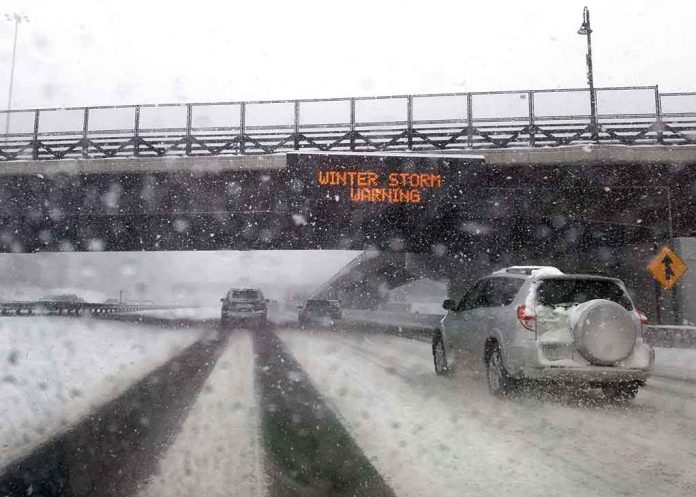
Winter driving hazards claim lives and cause accidents, but preparation can save you.
At a Glance
- Winter conditions contribute to over 540,000 vehicle accidents annually in the U.S.
- Proper vehicle maintenance and emergency kits are crucial for winter driving safety.
- Slow speeds, increased following distances, and avoiding sudden movements are key safety practices.
- Stay informed about weather forecasts and road conditions before traveling.
The Dangers of Winter Driving
As the chill of winter settles in, American drivers face increased risks on the road. The Federal Emergency Management Agency (FEMA) reports that winter weather significantly raises the likelihood of vehicular accidents, with over 540,000 incidents occurring annually in the United States. This sobering statistic underscores the critical need for heightened awareness and preparation when venturing out onto winter roads.
Preparing Your Vehicle for Winter Challenges
The first line of defense against winter driving hazards is a well-maintained vehicle. Cold weather can significantly affect car performance, impacting tire pressure, battery efficiency, and fluid consistency. Before the winter season hits, it’s crucial to have your vehicle thoroughly checked. This includes ensuring proper oil levels, antifreeze, and tire pressure.
While the safest option is to avoid driving in severe winter conditions, it’s not always possible. For those times when travel is necessary, equipping your vehicle with all-season or winter tires can provide better traction on slippery surfaces. Additionally, assembling an emergency kit is crucial. This should include blankets, a flashlight, a shovel, an ice scraper, a first aid kit, and non-perishable snacks. These items can be lifesavers if you find yourself stranded in harsh winter conditions.
Essential Winter Driving Techniques
When winter weather strikes, adopting specific driving techniques can significantly reduce your risk of accidents. The golden rule of winter driving is to slow down. Reduced speeds give you more time to react to hazards and help maintain control of your vehicle on slippery roads. It’s also crucial to increase your following distance from other vehicles.
Avoid sudden movements, whether accelerating, braking, or steering. These actions can cause your vehicle to lose traction and potentially lead to a skid. If you do find yourself in a skid, remember to steer into the direction of the skid and avoid slamming on the brakes. Familiarize yourself with your vehicle’s anti-lock braking system (ABS) and how it functions in winter conditions.
Planning and Awareness: Key to Winter Driving Safety
Before embarking on any winter journey, thorough planning is essential. Check weather forecasts and road conditions along your intended route. The National Weather Service and FEMA App are excellent resources for up-to-date information. If conditions are particularly severe, consider postponing non-essential travel. When travel is unavoidable, inform others of your plans and expected arrival time.
Pay special attention to bridges, overpasses, and ramps, as these areas tend to freeze first and remain icy longer than other road surfaces. Be vigilant when approaching hill crests, as visibility of road conditions ahead may be limited.
Remember, winter driving demands extra caution and preparedness. By following these guidelines and staying informed, you can significantly reduce your risk of becoming another winter driving statistic. Stay safe, stay alert, and when in doubt, stay home.
Sources:
- How to Drive in Snow and Ice: Winter Driving Safety Tips
- Winter Driving Safety Tips
- 10 Tips to Stay Safe on the Road this Winter
- Driving in Winter? Tips From Experts on How to Arrive Safely










